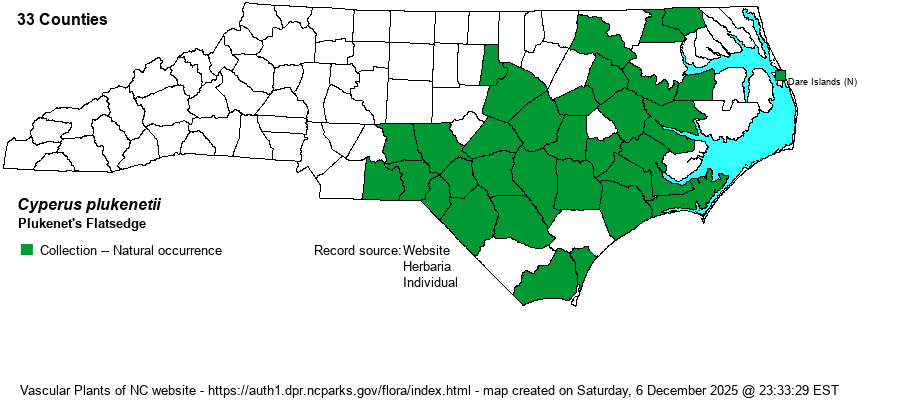| Author | Fernald | |
| Distribution | Coastal Plain and Sandhills, barely to the lowermost Piedmont.
NJ to KY and MO, south to central FL and eastern TX. | |
| Abundance | Frequent in the Sandhills and the Coastal Plain; rare in the lower Piedmont. Apparently rare in the northeastern Coastal Plain. | |
| Habitat | Dry to xeric Longleaf Pine-oak communities, other open pine-oak habitats. | |
| Phenology | Flowering and fruiting July-October. | |
| Identification | As the alternate name Starburst Flatsedge implies, the wide-spreading inflorescence looks like a fireworks display. The 5-10 spikes are obovoid and occur at the ends of very long stalks. Similar in gestalt to C. retrofractus and C. hystricinus, but it differs in its very short spikes (half as long). This is a very striking species, one of the more "handsome" graminoids of dry sandhills habitats. | |
| Taxonomic Comments | None
The genus Cyperus is mostly tropical and warm-temperate in distribution; thus, in NC it is much commoner in the Coastal Plain than in the Mountains and Piedmont. Most species have 1-few flowering stems (culms) from grasslike basal leaves, plus a few stem leaves. At the summit is an inflorescence of very open and branched, or tightly packed, spikes, varying among species from brown to golden brown to straw-color to reddish. The arrangement of the spikelets is important, whether like a hand (digitate) or in paired or alternate rows (pinnate); as is the shape of the achene (seed), whether bi-convex in cross-section or triangular. As a group, Cyperus tends to be weedy and readily enters disturbed ground; this is true for many natives as well as all the aliens. In recent years, following DNA research, the genus has incorporated several genera that in RAB (1968) or other manuals were separate: Hemicarpha, Lipocarpha, and Kyllinga. | |
| Other Common Name(s) | Starburst Flatsedge | |
| State Rank | S4 | |
| Global Rank | G5 | |
| State Status | | |
| US Status | | |
| USACE-agcp | | |
| USACE-emp | | |

